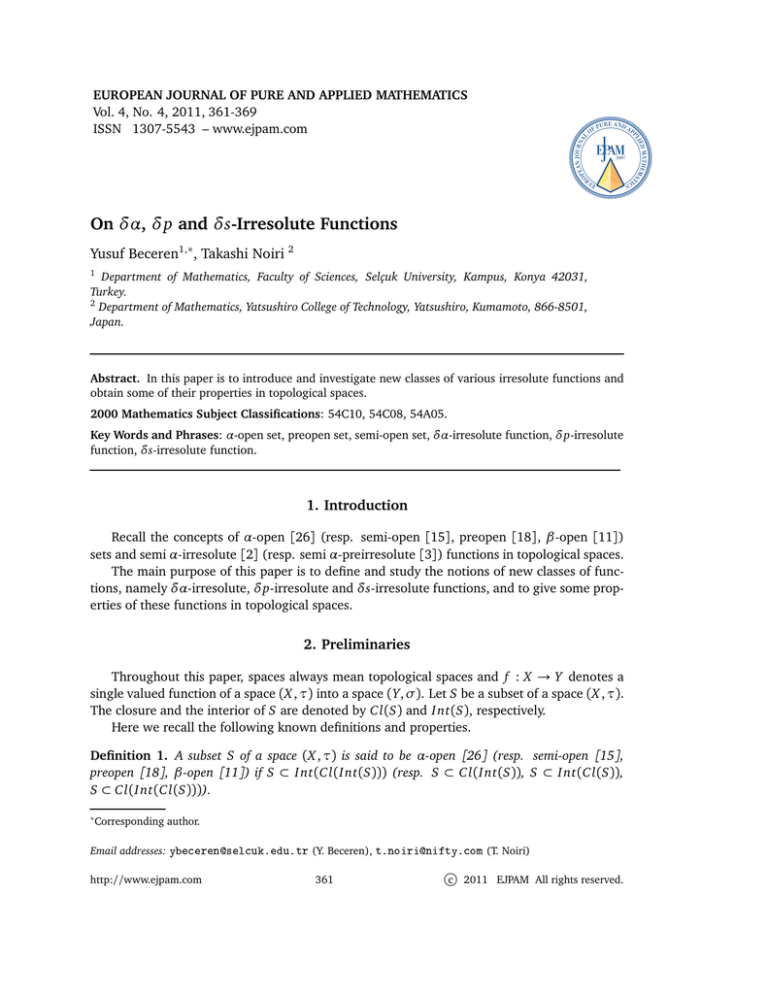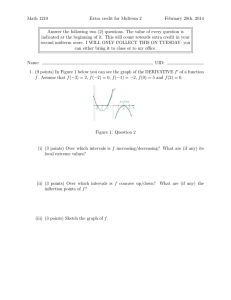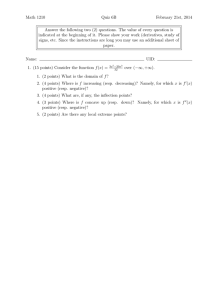
EUROPEAN JOURNAL OF PURE AND APPLIED MATHEMATICS
Vol. 4, No. 4, 2011, 361-369
ISSN 1307-5543 – www.ejpam.com
On δα, δp and δs-Irresolute Functions
Yusuf Beceren1,∗ , Takashi Noiri 2
1
Department of Mathematics, Faculty of Sciences, Selçuk University, Kampus, Konya 42031,
Turkey.
2
Department of Mathematics, Yatsushiro College of Technology, Yatsushiro, Kumamoto, 866-8501,
Japan.
Abstract. In this paper is to introduce and investigate new classes of various irresolute functions and
obtain some of their properties in topological spaces.
2000 Mathematics Subject Classifications: 54C10, 54C08, 54A05.
Key Words and Phrases: α-open set, preopen set, semi-open set, δα-irresolute function, δp-irresolute
function, δs-irresolute function.
1. Introduction
Recall the concepts of α-open [26] (resp. semi-open [15], preopen [18], β-open [11])
sets and semi α-irresolute [2] (resp. semi α-preirresolute [3]) functions in topological spaces.
The main purpose of this paper is to define and study the notions of new classes of functions, namely δα-irresolute, δp-irresolute and δs-irresolute functions, and to give some properties of these functions in topological spaces.
2. Preliminaries
Throughout this paper, spaces always mean topological spaces and f : X → Y denotes a
single valued function of a space (X , τ) into a space (Y, σ). Let S be a subset of a space (X , τ).
The closure and the interior of S are denoted by C l(S) and I nt(S), respectively.
Here we recall the following known definitions and properties.
Definition 1. A subset S of a space (X , τ) is said to be α-open [26] (resp. semi-open [15],
preopen [18], β-open [11]) if S ⊂ I nt(C l(I nt(S))) (resp. S ⊂ C l(I nt(S)), S ⊂ I nt(C l(S)),
S ⊂ C l(I nt(C l(S)))).
∗
Corresponding author.
Email addresses: ybeerenseluk.edu.tr (Y. Beceren), t.noirinifty.om (T. Noiri)
http://www.ejpam.com
361
c 2011 EJPAM All rights reserved.
Y. Beceren, T. Noiri / Eur. J. Pure Appl. Math, 4 (2011), 361-369
362
A point x ∈ X is called the δ-cluster point of A if A ∩ I nt(C l(U)) 6= ∅ for every open set U
of X containing x. The set of all δ-cluster points of A is called the δ-cluster of A, denoted by
C lδ (A). A subset A of X is called δ-closed [27] if A = C lδ (A). The complement of a δ-closed
set is called δ-open [27]. A subset A of X is said to be a δ-semiopen [23] if there exists a
δ-open set U of X such that U ⊂ A ⊂ C l(U). The complement of a δ-semiopen set is called
δ-semiclosed set. A point x ∈ X is called the δ-semicluster point of A if A ∩ U 6= ∅ for every
δ-semiopen set U of X containing x. The set of all δ-semicluster points of A is called the
δ-semiclosure [23] of A, denoted by δC ls (A). The family of all α-open (resp. semi-open,
preopen, β-open, δ-open, δ-semiopen) sets in a space (X , τ) is denoted by τα = α(X ) (resp.
SO(X ), PO(X ), βO(X ), δO(X ), δSO(X )). It is shown in [26] that τα is a topology for X .
Moreover, τ ⊂ τα = PO(X ) ∩ SO(X ) ⊂ βO(X ).
The complement of an α-open (resp. preopen, semi-open) set is said to be α-closed [17]
(resp. preclosed [18], semi-closed [8]). The intersection of all α-closed (resp. preclosed,
semi-closed) sets in (X , τ) containing a subset A is called the α-closure [17] (resp. preclosure
[10], semi-closure [8]) of A, denoted by αC l(A) (resp. pC l(A), sC l(A)).
The union of all α-open (resp. preopen, semi-open, δ-open) sets of X contained in A is
called the α-interior [1] (resp. preinterior [19], semi-interior [8], δ-interior [27]) of A and is
denoted by αlnt(A) (resp. plnt(A), sI nt(A), I nt δ (A)).
A subset S of a space (X , τ) is δ-semiopen [23] (resp. δ-semiclosed) if S ⊂ C l(I nt δ (S))
(resp. I nt(C lδ (S)) ⊂ S).
Lemma 1 (Park et al. [23]). The intersection (resp. union) of arbitrary collection of δsemiclosed (resp. δ-semiopen) sets in (X,τ) is δ-semiclosed (resp. δ-semiopen). And A ⊂ X
is δ-semiclosed if and only if A = δC ls (A).
Lemma 2 ([7, 10, 22, 14]). Let {X λ :λ ∈ Λ} be any family of topological spaces and Uλi be a
nonempty subset of X λi for each i = 1, 2, . . . , n. Then U = Πλ6=λi X λ × Πni=1 Uλi is a nonempty
α-open [7] (resp. preopen [10], semi-open [22], δ-semiopen [14]) subset of ΠX λ if and only if
Uλi is α-open (resp. preopen, semi-open, δ-semiopen) in X λi for each i = 1, 2, . . . , n.
Lemma 3. Let A and B be subsets of a space (X , τ). Then we have
(1) If AεδSO(X ) and BεδO(X ), then A ∩ BεδSO(B) [14].
(2) If AεδSO(B) and BεδO(X ), then AεδSO(X ) [6].
Definition 2. A function f : (X , τ) → (Y, σ) is said to be:
• semi α-irresolute [2] if f −1 (V ) is semi-open set in X for every α-open subset V of Y .
• semi α-preirresolute [3] if f −1 (V ) is semi-open set in X for every preopen subset V of Y .
• (δ,β)-irresolute [6] if f −1 (V ) is δ-semiopen set in X for every β-open subset V of Y .
• δ-semi-continuous [25] if f −1 (V ) is δ-semiopen set in X for every open subset V of Y .
• α-irresolute [17] if f −1 (V ) is α-open set in X for every α-open subset V of Y .
Y. Beceren, T. Noiri / Eur. J. Pure Appl. Math, 4 (2011), 361-369
363
• preirresolute [24] if f −1 (V ) is preopen set in X for every preopen subset V of Y .
• irresolute [9] if f −1 (V ) is semi-open set in X for every semi-open subset V of Y .
3. δα, δp and δs-Irresolute Functions
Definition 3. A function f : (X , τ) → (Y, σ) is said to be δα-irresolute, δp-irresolute and δsirresolute if f −1 (V ) is δ-semiopen set in X for every α-open (resp. preopen, semi-open) subset V
of Y .
From the definitions, we have the following relationships:
(δ, β) − irresoluteness → δp − irresoluteness → semi − α − preirresoluteness
↓
↓
↓
δs − irresoluteness
→ δα − irresoluteness →
semi − α − irresoluteness
However the converses of the above implications are not true in general by the following
examples.
Example 1. Let X = {a, b, c} with topologies τ = {X , ∅, {a, b}} and σ = {X , ∅, {a}, {b}, {a, b}}.
Let a function f : (X , τ) → (X , σ) be defined by f (a) = f (b) = a and f (c) = c. Then f is semi
α-preirresolute and hence semi α-irresolute but it is neither δα-irresolute, δs-irresolute nor δpirresolute.
Example 2. Let X = {a, b, c, d} with topologies τ = {X , ∅, {a, b, c}} and
σ = {X , ∅, {a}, {b, c}, {a, b, c}}. Let a function f : (X , τ) → (X , σ) be defined by
f (a) = f (b) = f (c) = b and f (d) = c. Then f is δs-irresolute and hence δα-irresolute but it is
not semi α-preirresolute.
Theorem 1. For a function f : (X , τ) → (Y, σ), the following are equivalent:
(a) f is δα-irresolute;
(b) f : (X , τ) → (Y, σα ) is δ-semi-continuous;
(c) For each x ∈ X and each α-open set V of Y containing f (x), there exists a δ-semiopen set
U of X containing x such that f (U) ⊂ V ;
(d) f −1 (V ) ⊂ C l(I nt δ ( f −1 (V ))) for every α-open set V of Y ;
(e) f −1 (F) is δ-semiclosed in X for every α-closed set F of Y ;
(f) I nt(C lδ ( f −1 (B))) ⊂ f −1 (αC l(B)) for every subset B of Y ;
(g) f (I nt(C lδ (A))) ⊂ αC l( f (A)) for every subset A of X .
Y. Beceren, T. Noiri / Eur. J. Pure Appl. Math, 4 (2011), 361-369
364
Proof. (a) ⇒ (b). Let x ∈ X and V be any α-open set of Y containing f (x). By Definition
3, f −1 (V )εδSO(X ) containing x and hence f : (X , τ) → (Y, σα ) is δ-semi-continuous.
(b) ⇒ (c). Let x ∈ X and V be any α-open set of Y containing f (x). Set U = f −1 (V ),
then by (b), U is a δ-semiopen set of X containing x and f (U) ⊂ V .
(c) ⇒ (d). Let V be any α-open subset of Y and x ∈ f −1 (V ). By (c), there exists a δsemiopen set U of X containing x such that f (U) ⊂ V . Therefore, we obtain
x ∈ U ⊂ C l(I nt δ (U)) ⊂ C l(I nt δ ( f −1 (V ))) and hence f −1 (V ) ⊂ C l(I nt δ ( f −1 (V ))).
(d) ⇒ (e). Let F be any α-closed subset of Y . Set V = Y − F, then V is α-open in Y . By
(d), we have f −1 (V ) ⊂ C l(I nt δ ( f −1 (V ))) and hence f −1 (F) = X −( f −1 (Y −F)) = X − f −1 (V )
is δ-semiclosed in X .
(e) ⇒ (f). Let B be any subset of Y . Since αC l(B) is α-closed in Y , f −1 (αC l(B))
is δ-semiclosed in X and hence I nt(C lδ ( f −1 (αC l(B)))) ⊂ f −1 (αC l(B)). Thus we have
I nt(C lδ ( f −1 (B))) ⊂ f −1 (αC l(B)).
(f) ⇒ (g). Let A be any subset of X . By ( f ), we obtain
I nt(C lδ (A)) ⊂ I nt(C lδ ( f −1 ( f (A)))) ⊂ f −1 (αC l( f (A))) and hence f (I nt(C lδ (A))) ⊂ αC l( f (A)).
(g) ⇒ (a). Let V be any α-open subset of Y . Since f −1 (Y − V ) = X − f −1 (V ) is a subset
of X and by (g), we obtain
f (I nt(C lδ ( f −1 (Y − V )))) ⊂ αC l( f ( f −1 (Y − V ))) ⊂ αC l(Y − V ) = Y − αI nt(V ) = Y − V
and hence
X − C l(I nt δ ( f −1 (V ))) =I nt(C lδ (X − f −1 (V )))
=I nt(C lδ ( f −1 (Y − V ))) ⊂ f −1 ( f (I nt(C lδ ( f −1 (Y − V ))))) ⊂ f −1 (Y − V )
=X − f −1 (V ).
Therefore, we have f −1 (V ) ⊂ C l(I nt δ ( f −1 (V ))) and hence f −1 (V ) is δ-semiopen in X . Thus
the function f is δα-irresolute.
Now, the proofs of the following two theorems are similar to Theorem 1 and are thus
omitted.
Theorem 2. The following are equivalent for a function f : (X , τ) → (Y, σ):
(a) f is δp-irresolute;
(b) For each x ∈ X and each preopen set V of Y containing f (x), there exists a δ-semiopen set
U of X containing x such that f (U) ⊂ V ;
(c) f −1 (V ) ⊂ C l(I nt δ ( f −1 (V ))) for every preopen set V of Y ;
(d) f −1 (F) is δ-semiclosed in X for every preclosed set F of Y ;
(e) I nt(C lδ ( f −1 (B))) ⊂ f −1 (pC l(B)) for every subset B of Y ;
(f) f (I nt(C lδ (A))) ⊂ pC l( f (A)) for every subset A of X .
Y. Beceren, T. Noiri / Eur. J. Pure Appl. Math, 4 (2011), 361-369
365
Theorem 3. For a function f : (X , τ) → (Y, σ), the following are equivalent:
(a) f is δs-irresolute;
(b) For each x ∈ X and each semi-open set V of Y containing f (x), there exists a δ-semiopen
set U of X containing x such that f (U) ⊂ V ;
(c) f −1 (V ) ⊂ C l(I nt δ ( f −1 (V ))) for every semi-open set V of Y ;
(d) f −1 (F) is δ-semiclosed in X for every semi-closed set F of Y ;
(e) I nt(C lδ ( f −1 (B))) ⊂ f −1 (sC l(B)) for every subset B of Y ;
(f) f (I nt(C lδ (A))) ⊂ sC l( f (A)) for every subset A of X .
The proofs of the other parts of the following theorems follow by a similar way and are
thus omitted.
Theorem 4. Let f : X → Y be a function and g : X → X × Y the graph function, given by
g(x) = (x, f (x)) for every x ∈ X . Then f is δα-irresolute (resp. δp-irresolute, δs-irresolute) if
g is δα-irresolute (resp. δp-irresolute, δs-irresolute).
Proof. Let x ∈ X and V be any α-open (resp. preopen,semi-open) set of Y containing f (x).
Then, by Lemma 2, The set X × V is α-open (resp. preopen, semi-open) in X × Y containing
g(x). Since g is δα-irresolute (resp. δp-irresolute, δs-irresolute), there exists a δ-semiopen
set U of X containing x such that g(U) ⊂ X × V and hence f (U) ⊂ V . Thus f is δα-irresolute
(resp. δp-irresolute, δs-irresolute).
Theorem 5. If a function f : X → ΠYλ is δα-irresolute (resp. δp-irresolute, δs-irresolute), then
Pλ o f : X → Yλ is δα-irresolute (resp. δp-irresolute, δs-irresolute) for each λ ∈ Λ, where Pλ is
the projection of ΠYλ onto Yλ .
Proof. Let Vλ be any α-open (resp. preopen, semi-open) set of Yλ . Since Pλ is continuous
and open, it is α-irresolute [20, Theorem 3.2] (resp. preirresolute [20, Theorem 3.4], irresolute [9, Theorem 1.2]) and hence Pλ−1 (Vλ ) is α-open (resp. preopen, semi-open) in ΠYλ . Since
f is δα-irresolute (resp. δp-irresolute, δs-irresolute), then f −1 (Pλ−1 (Vλ )) = (Pλ o f )−1 (Vλ ) is
δ-semiopen in X . Hence Pλ o f is δα-irresolute (resp. δp-irresolute, δs-irresolute) for each
λ ∈ Λ.
Theorem 6. If the product function f : ΠX λ → ΠYλ is δα-irresolute (resp. δp-irresolute, δsirresolute), then fλ : X λ → Yλ is δα-irresolute (resp. δp-irresolute, δs-irresolute) for each λ ∈ Λ.
Proof. Let λ0 ∈ Λ be an arbitrary fixed index and Vλ0 be any α-open (resp. preopen, semiopen) set of Yλ0 . Then ΠYλ × Vλ0 is α-open (resp. preopen, semi-open) in ΠYλ by Lemma
2, where λ0 6= λ ∈ Λ. Since f is δα-irresolute (resp. δp-irresolute, δs-irresolute), then
f −1 (ΠYλ × Vλ0 ) = ΠX λ × fλ−1 (Vλ0 ) is δ-semiopen in ΠX λ and hence, by Lemma 2, fλ−1 (Vλ0 ) is
0
0
δ-semiopen in X λ0 . This implies that fλ0 is δα-irresolute (resp. δp-irresolute, δs-irresolute).
Y. Beceren, T. Noiri / Eur. J. Pure Appl. Math, 4 (2011), 361-369
366
Theorem 7. If f : (X , τ) → (Y, σ) is δα-irresolute (resp. δp-irresolute, δs-irresolute) and A
is a δ-open subset of X , then the restriction f/A : A → Y is δα-irresolute (resp. δp-irresolute,
δs-irresolute).
Proof. Let V be any α-open (resp. preopen, semi-open) set of Y . Since f is δα-irresolute
(resp. δp-irresolute, δs-irresolute), then f −1 (V ) is δ-semiopen in X . Since A is δ-open in X ,
( f/A)−1 (V ) = A ∩ f −1 (V ) is δ-semiopen in A by the condition (1) of Lemma 3. Hence f/A is
δα-irresolute (resp. δp-irresolute, δs-irresolute).
Theorem 8. Let f : (X , τ) → (Y, σ) be a function and {Aλ : λ ∈ Λ} be a cover of X by δ-open
sets of (X , τ). Then f is δα-irresolute (resp. δp-irresolute, δs-irresolute) if f/Aλ : Aλ → Y is
δα-irresolute (resp. δp-irresolute, δs-irresolute) for each λ ∈ Λ.
Proof. Let V be any α-open (resp. preopen, semi-open) set of Y . Since f/Aλ is δα-irresolute
(resp. δp-irresolute, δs-irresolute), then ( f/Aλ )−1 (V ) = f −1 (V ) ∩ Aλ is δ-semiopen in Aλ .
Since Aλ is δ-open in X , by the condition (2) of Lemma 3, ( f/Aλ )−1 (V ) is δ-semiopen in X for
λ ∈ Λ. Therefore f −1 (V ) = X ∩ f −1 (V ) = ∪{Aλ ∩ f −1 (V ) : λ ∈ Λ} = ∪{( f/Aλ )−1 (V ) : λ ∈ Λ}
is δ-semiopen in X because the union of δ-semiopen sets is a δ-semiopen set by Lemma 1.
Hence f is δα-irresolute (resp. δp-irresolute, δs-irresolute).
Theorem 9. Let f : X → Y and g : Y → Z be functions. Then the composition go f : X → Z
is δα-irresolute (resp. δp-irresolute, δs-irresolute) if f is δα-irresolute (resp. δp-irresolute,
δs-irresolute) and g is α-irresolute (resp. preirresolute, irresolute).
Proof. Let W be any α-open (resp. preopen, semi-open) subset of Z. Since g is α-irresolute
(resp. preirresolute, irresolute), g −1 (W ) is α-open (resp. preopen, semi-open) in Y . Since
f is δα-irresolute (resp. δp-irresolute, δs-irresolute), then (go f )−1 (W ) = f −1 (g −1 (W )) is
δ-semiopen in X and hence go f is δα-irresolute (resp. δp-irresolute, δs-irresolute).
We recall that a space (X , τ) is said to be submaximal [4] if every dense subset of X is
open in X and extremally disconnected [26] if the closure of each open subset of X is open in
X . The following theorem follows from the fact that if (X , τ) is a submaximal and extremally
disconnected space, then τ = τα = SO(X ) = PO(X ) = βO(X ) [12, 21].
Theorem 10. Let (Y, σ) be a submaximal and extremally disconnected space and let
f : (X , τ) → (Y, σ) be a function. Then we have
δα-irresoluteness ⇔ δp-irresoluteness ⇔ δs − irresoluteness ⇔ (δ, β)-irresoluteness.
Recall that a topological space (X , τ) is called α − T2 [17] (resp. pre-T2 [13], semi-T2
[16], δ-semi-T2 [5] if for any distinct pair of points x and y in X , there exist Uεα(X , x) and
V εα(X , y) (resp. UεPO(X , x) and V εPO(X , y), UεSO(X , x) and V εSO(X , y), UεδSO(X , x)
and V εδSO(X , y)) such that U ∩ V = ∅.
Theorem 11. If f : (X , τ) → (Y, σ) is δα-irresolute (resp. δp-irresolute, δs-irresolute) injection
and Y is α − T2 (resp. pre-T2 , semi-T2 ), then X is δ-semi-T2 .
Y. Beceren, T. Noiri / Eur. J. Pure Appl. Math, 4 (2011), 361-369
367
Proof. Let x and y be distinct points of X . Then f (x) 6= f ( y). Since Y is α − T2 (resp. preT2 , semi-T2 ), there exist disjoint α-open (resp. preopen, semi-open) sets V and W containing
f (x) and f ( y), respectively. Since f is δα-irresolute (resp. δp-irresolute, δs-irresolute),
there exist δ-semiopen sets U and H containing x and y, respectively, such that f (U) ⊂ V
and f (H) ⊂ W . It follows that U ∩ H = ∅. This shows that X is δ-semi-T2 .
Lemma 4 (Lee et. al. [14]). If Ai is a δ-semiopen set of X i (i = 1, 2), then A1 × A2 is δ-semiopen
in X 1 × X 2 .
Theorem 12. If f : (X , τ) → (Y, σ) is δα-irresolute (resp. δp-irresolute, δs-irresolute) and Y is
α − T2 (resp. pre-T2 , semi-T2 ), then the set E = {(x, y) : f (x) = f ( y)} is δ-semiclosed in X × X .
Proof. Suppose that (x, y) ∈
/ E. Then f (x) 6= f ( y). Since Y is α − T2 (resp. pre-T2 , semiT2 ), there exist V εα(Y, f (x)) and W εα(Y, f ( y)) (resp. V εPO(Y, f (x)) and W εPO(Y, f ( y)),
V εSO(Y, f (x)) and W εSO(Y, f ( y))) such that V ∩ W = ∅. Since f is δα-irresolute (resp.
δp-irresolute, δs-irresolute), there exist δ-semiopen sets U and H containing x and y, respectively, such that f (U) ⊂ V and f (H) ⊂ W . Set G = U × H. By Lemma 4,
(x, y) ∈ G ∈ δSO(X × X ) and G ∩ E = ∅. This means that δC ls (E) ⊂ E and hence the set E is
δ-semiclosed in X × X .
Definition 4. For a function f : X → Y , the graph G( f ) = {(x, f (x)) : x ∈ X } is called δαclosed (resp. δp-closed, δs-closed) if for each (x, y) ∈ (X × Y ) − G( f ), there exist UεδSO(X , x)
and V εα(Y, y) (resp. V εPO(Y, y), V εSO(Y, y)) such that (U × V ) ∩ G( f ) = ∅.
Theorem 13. If f : X → Y is δα-irresolute (resp. δp-irresolute, δs-irresolute) and Y is α − T2
(resp. pre-T2 , semi-T2 ), then G( f ) is δα-closed (resp. δp-closed, δs-closed) in X × Y .
Proof. Let (x, y) ∈ (X × Y ) − G( f ). This implies that f (x) 6= y. Since Y is α − T2
(resp. pre-T2 , semi-T2 ), there exist disjoint α-open (resp. preopen, semi-open) sets V and W
in Y containing f (x) and y, respectively. Since f is δα-irresolute (resp. δp-irresolute, δsirresolute), there exists a δ-semiopen set U of X containing x such that f (U) ⊂ V . Therefore
f (U) ∩ W = ∅ and hence (U × W ) ∩ G( f ) = ∅. Thus G( f ) is δα-closed (resp. δp-closed,
δs-closed) in X × Y .
Theorem 14. If f : X → Y is δα-irresolute (resp. δp-irresolute, δs-irresolute) injection with a
δα-closed (resp. δp-closed, δs-closed) graph, then X is δ-semi-T2 .
Proof. Let x and y be any distinct points of X . Then f (x) 6= f ( y) and hence
(x, f ( y)) ∈ (X × Y ) − G( f ). Since G( f ) is δα-closed (resp. δp-closed, δs-closed), there exist
UεδSO(X , x) and V εα(Y, f ( y)) (resp. V εPO(Y, f ( y)), V εSO(Y, f ( y))) such that
(U × V ) ∩ G( f ) = ∅ and hence f (U) ∩ V = ∅. Since f is δα-irresolute (resp. δp-irresolute,
δs-irresolute), there exists GεδSO(X , y) such that f (G) ⊂ V . Thus we have f (U) ∩ f (G) = ∅
and hence U ∩ G = ∅. This shows that X is δ-semi-T2 .
REFERENCES
368
References
[1] D Andrijević. Some properties of the topolgy of α-sets. Mat. Vesnik, 36:1–10, 1984.
[2] Y Beceren. On semi α-irresolute functions. J. Indian Acad. Math., 22:353–362, 2000.
[3] Y Beceren. Strongly semi β-irresolute functions and semi α-preirresolute functions. Far
East J. Math. Sci. (FJMS), 3:973–983, 2001.
[4] N Bourbaki. Elements of Mathematics, General Topology, Part 1,Hermann. Addison-Wesley
Publishing Co. Reading, Mass. Paris, 1966.
[5] M Caldas, D Georgiou, S Jafari, and T Noiri. More on δ-semiopen sets. Note Mat.,
22:113–126, 2003.
[6] M Caldas, S Jafari, and R Saraf. On a non-continuous and stronger form of Levine’s
semi-continuous functions. Math. Commun., 14:19–25, 2009.
[7] G Chae, T Noiri, and D Lee. On na-continuous functions. Kyungpook Math. J., 26:73–79,
1986.
[8] S Crossley and S Hildebrand. Semi-closure. Texas J. Sci., 22:99–112, 1971.
[9] S Crossley and S Hildebrand. Semi-topological properties. Fund Math., 74:233–254,
1972.
[10] S El-Deeb, I Hasanein, A Mashhour, and T Noiri. On p-regular spaces. Bull. Math. Soc.
Sci. Math. R. S. Roumanie (N. S.), 27(75):311–315, 1983.
[11] M Abd El-Monsef, S El-Deeb, and R Mahmoud. β-open sets and β-continuous mapping.
Bull. Fac. Sci. Assiut Univ. A, 12:77–90, 1983.
[12] D Janković. On locally irreducible spaces. Ann. Soc. Sci. Bruxelles Sér. I, 97:59–72, 1983.
[13] A Kar and P Bhattacharyya. Some weak separation axioms. Bull. Calcutta Math. Soc.,
82:415–422, 1990.
[14] B Lee, M Son, and J Park. δ-semiopen sets and its applications. Far East J. Math. Sci.
(FJMS), 3:745–759, 2001.
[15] N Levine. Semi open sets and semi continuity in topological spaces. Amer. Math.
Monthly, 70:36–41, 1963.
[16] S Maheshwari and R Prasad. Some new separation axioms. Ann. Soc. Sci. Bruxelles Sér.
I, 89:395–402, 1975.
[17] S Maheshwari and S Thakur. On α-irresolute mappings. Tamkang J. Math., 11:209–214,
1980.
REFERENCES
369
[18] A Mashhour, M Abd El-Monsef, and S El-Deeb. On precontinuous and weak precontinuous mappings. Proc. Math. Phys. Soc. Egypt, 53:47–53, 1982.
[19] A Mashhour, M Abd El-Monsef, and I Hasanein. On pretopological spaces. Bull. Math.
Soc. Sci. Math. R. S. Roumanie (N. S.), 28 (76):39–45, 1984.
[20] A Mashhour, I Hasanein, and S El-Deeb. α-continuous and α-open mappings. Acta Math.
Hungar., 41:213–218, 1983.
[21] A Nasef and T Noiri. Strong forms of faint continuity. Mem. Fac. Sci. Kochi Univ. Ser. A
Math., 19:21–28, 1998.
[22] T Noiri. Remarks on semi-open mappings. Bull. Calcutta Math. Soc., 65:197–201, 1973.
[23] J Park, B Lee, and M Son. On δ-semiopen sets in topological spaces. J. Indian Acad.
Math., 19:59–67, 1997.
[24] I Reilly and M Vamanamurthy. On α-continuity in topological spaces. Acta Math. Hungar., 45:27–32, 1985.
[25] M Son. On δ-semiopen sets and δ-semicontinuous functions. PhD thesis, Dong Univ.,
1999.
[26] O Njåstad. On some classes of nearly open sets. Pacific J. Math., 15:961–970, 1965.
[27] N Veličko. H-closed topological spaces. Amer. Math. Soc. Transl., (2)78:103–118, 1968.




